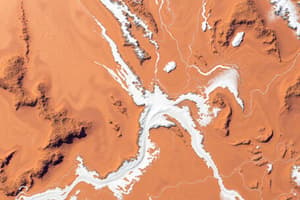Podcast
Questions and Answers
What type of wind can mountains create that brings warm air from warmer regions into colder valleys?
What type of wind can mountains create that brings warm air from warmer regions into colder valleys?
- Trade winds
- Polar easterlies
- Chinook winds (correct)
- Monsoon winds
How can coastlines influence wind patterns during the day and night?
How can coastlines influence wind patterns during the day and night?
- By causing monsoon winds
- By leading to sea breezes during the day and land breezes at night (correct)
- By generating blizzards
- By creating tornadoes
What meteorological phenomenon occurs when moist air rises above mountains, leading to cloud formation and precipitation?
What meteorological phenomenon occurs when moist air rises above mountains, leading to cloud formation and precipitation?
- Orographic lift (correct)
- Polar vortex
- El Niño
- Heatwave
What type of wind can develop if there is a significant temperature difference between the upper and lower slopes of mountains?
What type of wind can develop if there is a significant temperature difference between the upper and lower slopes of mountains?
How does topography influence regional climate according to the text?
How does topography influence regional climate according to the text?
Which wind pattern is characterized by cold air moving from the land towards the sea at night?
Which wind pattern is characterized by cold air moving from the land towards the sea at night?
What term describes the strong, narrow winds high in the Earth's atmosphere where air masses meet?
What term describes the strong, narrow winds high in the Earth's atmosphere where air masses meet?
How do large bodies of water influence wind patterns according to the text?
How do large bodies of water influence wind patterns according to the text?
Which factor plays a significant role in shaping wind patterns by creating rain shadows?
Which factor plays a significant role in shaping wind patterns by creating rain shadows?
Ocean currents near coastlines mainly influence wind patterns by _____.
Ocean currents near coastlines mainly influence wind patterns by _____.
Which type of wind is primarily responsible for distributing cold polar air southward and warm tropical air northward throughout the year?
Which type of wind is primarily responsible for distributing cold polar air southward and warm tropical air northward throughout the year?
Wind movements described as 'surface winds' refer to _____.
Wind movements described as 'surface winds' refer to _____.
Flashcards are hidden until you start studying
Study Notes
Climate refers to the prevailing weather conditions in a given area over an extended period. It is determined by several complex interactions between various physical, chemical, and biological factors. Topography, which involves the study of landforms and their interaction with climate, is one such factor that plays a critical role in shaping local climates. In this section, we will discuss how topography influences climate through its impact on temperature, precipitation, wind patterns, and atmospheric stability.
Topographic features such as mountains, valleys, hills, and plateaus can influence climate in several ways:
-
Temperature: Changes in elevation affect air density and temperature due to the decrease in atmospheric pressure with altitude. As a result, higher elevations experience cooler temperatures compared to lower ones. For instance, mountainous regions generally have lower average temperatures compared to flatlands or coastal areas.
-
Precipitation: Topography can also affect precipitation due to the variation in winds and air masses flowing over different types of terrain. Mountain ranges, for example, act as barriers that either block or force moisture-laden winds to rise, leading to increased condensation and rainfall on the windward side while causing rain shadows on the leeward side. This process contributes to the creation of microclimates around these regions.
-
Wind Patterns: Topographical features like valleys, plateaus, and hills can cause wind direction changes, resulting in local variations in wind speed and direction. For example, mountains can create strong upslope flows known as "Chinook winds," which bring warm air from warmer regions into colder valleys. Similarly, coastlines can lead to sea breezes during daytime and land breezes at night due to the contrasting temperatures between water and land.
-
Atmospheric Stability: The interaction between topography and climate also affects atmospheric stability. Orographic lift occurs when moist air rises above mountains, cooling and condensing to form clouds and precipitation. On the other hand, downslope winds can develop if there is a significant difference in temperature between the upper and lower slopes, potentially causing unstable atmospheric conditions prone to severe weather events like thunderstorms.
In conclusion, topography significantly impacts regional climate through its effects on temperature, precipitation, wind patterns, and atmospheric stability. Understanding these relationships helps us better predict and manage the impacts of climate change on our environment and daily lives.
Studying That Suits You
Use AI to generate personalized quizzes and flashcards to suit your learning preferences.



